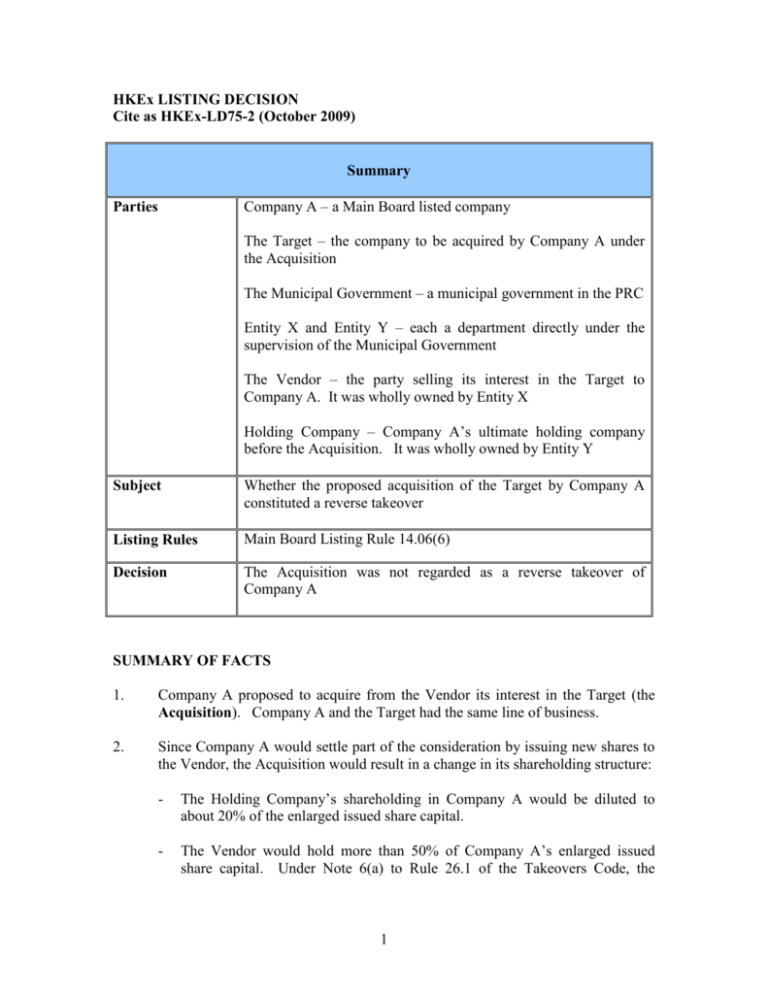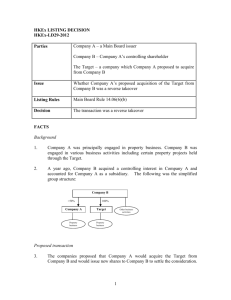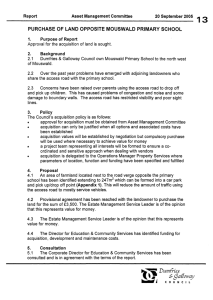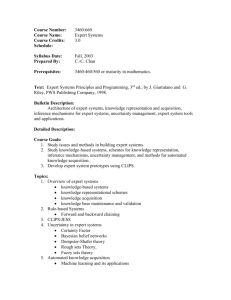Whether the proposed acquisition of the Target by Company
advertisement

HKEx LISTING DECISION Cite as HKEx-LD75-2 (October 2009) Summary Company A – a Main Board listed company Parties The Target – the company to be acquired by Company A under the Acquisition The Municipal Government – a municipal government in the PRC Entity X and Entity Y – each a department directly under the supervision of the Municipal Government The Vendor – the party selling its interest in the Target to Company A. It was wholly owned by Entity X Holding Company – Company A’s ultimate holding company before the Acquisition. It was wholly owned by Entity Y Subject Whether the proposed acquisition of the Target by Company A constituted a reverse takeover Listing Rules Main Board Listing Rule 14.06(6) Decision The Acquisition was not regarded as a reverse takeover of Company A SUMMARY OF FACTS 1. Company A proposed to acquire from the Vendor its interest in the Target (the Acquisition). Company A and the Target had the same line of business. 2. Since Company A would settle part of the consideration by issuing new shares to the Vendor, the Acquisition would result in a change in its shareholding structure: - The Holding Company’s shareholding in Company A would be diluted to about 20% of the enlarged issued share capital. - The Vendor would hold more than 50% of Company A’s enlarged issued share capital. Under Note 6(a) to Rule 26.1 of the Takeovers Code, the 1 Vendor was granted a waiver from its obligation to make a general offer for Company A as a result of the Acquisition. 3. The simplified group structures before and after the Acquisition are: Before the Acquisition The Municipal Government Entity X Entity Y 100% 100% Holding Company The Vendor >50% >50% Company A The Target After the Acquisition The Municipal Government Entity X Entity Y 100% 100% The Vendor Holding Company >50% 20% Company A >50% The Target 4. The Acquisition was a connected transaction for Company A as the Exchange had deemed the Vendor and its associates to be Company A’s connected persons since the listing of Company A. Based on the percentage ratio calculation, the Acquisition was also a very substantial acquisition. 2 5. Company A sought the Exchange’s confirmation that the Acquisition was not a reverse takeover under Rule 14.06(6). It submitted that although the Acquisition would result in the Vendor acquiring a controlling interest in Company A, there would not be a change in control under Rule 14.06(6) because: - Both Entity X and Entity Y were subordinate departments of the Municipal Government and under its supervision. Through these entities, the Municipal Government had exercised control over each of the Holding Company, Company A, the Vendor and the Target, including through the exercise of voting rights. - The Municipal Government had, and would continue to have, ultimate control over Company A before and after the Acquisition. ISSUE 6. Whether the Acquisition constituted a reverse takeover of Company A. APPLICABLE LISTING RULES OR PRINCIPLES 7. Rule 14.06(6) defines “reverse takeover” as: an acquisition or a series of acquisitions of assets by an issuer which, in the opinion of the Exchange, constitutes, or is part of a transaction or arrangement or series of transactions or arrangements which constitute, an attempt to achieve a listing of the assets to be acquired and a means to circumvent the requirements for new applicants set out in Chapter 8 of the Exchange Listing Rule. A “reverse takeover” normally refers to: (a) an acquisition or a series of acquisitions (aggregated under rules 14.22 and 14.23) of assets constituting a very substantial acquisition where there is or which will result in a change in control (as defined in the Takeovers Code) of the listed issuer (other than at the level of its subsidiaries); or (b) acquisition(s) of assets from a person or a group of persons or any of his/their associates pursuant to an agreement, arrangement or understanding entered into by the listed issuer within 24 months of such person or group of persons gaining control (as defined in the Takeovers Code) of the listed issuer (other than at the level of its subsidiaries), where such gaining of control had not been regarded as a 3 reverse takeover, which individually or constitute(s) a very substantial acquisition. … together ANALYSIS 8. Rule 14.06(6)(a) describes a specific form of reverse takeover that involves injection of significant assets into an issuer and a change in its control (as defined in the Takeovers Code). 9. Since the Municipal Government would remain Company A’s controlling shareholder following the Acquisition, there would not be a change in its ultimate control as a result of the Acquisition. 10. The Exchange also took into account the assessment of “control” under the Takeovers Code. In this case, the Takeovers Executive had granted a waiver to the Vendor from its obligation to make a general offer under Note 6(a) to Rule 26.1 of the Takeovers Code. This was different from the situation where the control of an issuer changed and a whitewash waiver was granted subject to independent shareholders’ approval under the Takeovers Code. DECISION 14. The Acquisition was not regarded as a reverse takeover of Company A. 4







